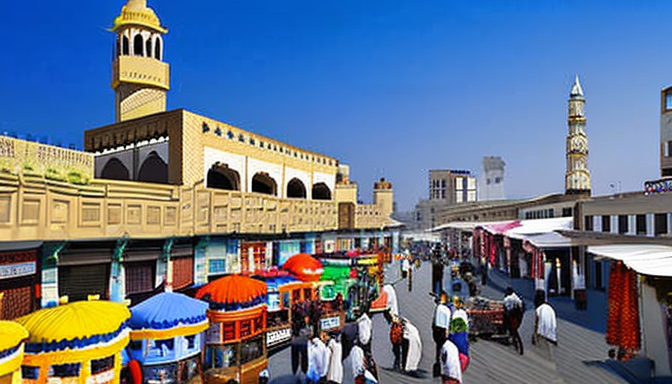Karachi, once a humble fishing village, has transformed into a bustling metropolis. This city’s history is a tapestry woven with significant events that shaped its identity over the centuries. Let’s take a stroll through time and explore the major milestones that defined Karachi.
In the early 18th century, Karachi was just a small port town. But then came the British in the 19th century. They saw potential. They saw opportunity. With their arrival, Karachi experienced major transformations. Infrastructure was developed. Roads, railways, and ports were built, connecting Karachi to the world. This was a game-changer for trade and commerce.
By the late 1800s, Karachi had become a major trading hub. The city was bustling with people from diverse backgrounds. Each brought their own culture, adding to the city’s vibrant mosaic. This was the beginning of Karachi’s identity as a melting pot. Can you imagine a place where every street corner tells a different story?
Fast forward to 1947, when Pakistan gained independence. Karachi was now the country’s first capital. The city witnessed rapid urbanization and demographic shifts. People flocked to Karachi, seeking new opportunities. This influx changed the city’s landscape and culture dramatically. It became a vital economic center, influencing the region’s dynamics.
Today, Karachi stands as a testament to resilience and growth. Its history is a reminder of how far it has come. From a small fishing village to a major metropolis, Karachi continues to evolve. Each milestone is a chapter in its ongoing story.
Colonial Era Transformations
The colonial era was a significant chapter in Karachi’s story, marking a time of profound change. Picture this: a small fishing village transformed into a bustling port city. How did that happen? It all began in the early 19th century when the British East India Company set its sights on Karachi. They recognized the city’s strategic location along the Arabian Sea, which opened up a world of trade possibilities.
As the British established their foothold, they introduced infrastructure that would forever change the landscape. Roads, railways, and ports sprang up, connecting Karachi not just to the rest of India but to the globe. This was the dawn of a new economic era. With trade routes bustling, the city became a melting pot of cultures. People from different backgrounds flocked to Karachi, each bringing their unique flavors and traditions.
Moreover, the colonial period saw the establishment of educational institutions and healthcare facilities, laying the groundwork for a more educated populace. The city began to attract skilled workers and entrepreneurs, further fueling its growth. By the late 19th century, Karachi was not just a port; it was a cultural hub, rich in diversity and opportunity.
To sum it up, the colonial era was like a double-edged sword. It brought progress and development but also laid the foundation for future challenges. Karachi’s transformation during this period is a testament to its resilience and ability to adapt. The city was no longer just a fishing village; it was on its way to becoming a major player in the region.

Post-Independence Developments
After gaining independence in 1947, Karachi didn’t just change; it transformed dramatically. Picture a bustling city, once a small fishing village, now swelling with people and energy. This period marked a surge in urbanization. The streets filled with newcomers, all seeking a better life. They brought their dreams, cultures, and traditions, creating a vibrant tapestry of diversity.
In the 1950s and 1960s, Karachi became a major economic hub. The government invested heavily in infrastructure. Roads, schools, and hospitals sprouted up. This was a time of hope and progress. People were eager to work, and the city buzzed with activity. Factories opened their doors, and commerce flourished. Karachi was not just growing; it was thriving.
Yet, this rapid growth came with its challenges. The influx of people strained resources. Housing became a pressing issue. Slums began to emerge, reflecting the stark contrast between wealth and poverty. But through it all, Karachi remained a melting pot. Different languages and cultures coexisted, enriching the city’s identity.
Fast forward to the 1980s, and Karachi was a city of contrasts. It was a place where tradition met modernity. Skyscrapers rose alongside old bazaars. The economy diversified, with sectors like finance, technology, and education taking root. Karachi was no longer just a port city; it was a beacon of opportunity.
Today, Karachi stands as a testament to resilience and adaptation. It has faced challenges, yet it continues to evolve. The city’s dynamic nature reflects its history—a blend of struggles and triumphs, making it a unique place to call home.
Frequently Asked Questions
- What were the major influences on Karachi during the colonial era?
During the colonial era, Karachi was transformed through the introduction of modern infrastructure, trade routes, and a mix of diverse cultures. This period set the stage for its rapid growth and development, making it a significant port city.
- How did Karachi evolve after gaining independence?
Post-independence, Karachi experienced an explosion of urbanization. The city became a melting pot of cultures as people from various regions flocked to its bustling streets, contributing to its rich tapestry of traditions and making it a vital economic hub.
- What are some key milestones in Karachi’s history?
Key milestones include its establishment as a trading port in the 19th century, the impact of British colonial rule, and its rapid growth following Pakistan’s independence. Each of these events played a crucial role in shaping the city’s identity.
- Why is Karachi considered an economic hub?
Karachi is often dubbed the economic powerhouse of Pakistan due to its strategic location, bustling ports, and diverse industries. It hosts a significant portion of the country’s trade and commerce, making it vital to the national economy.